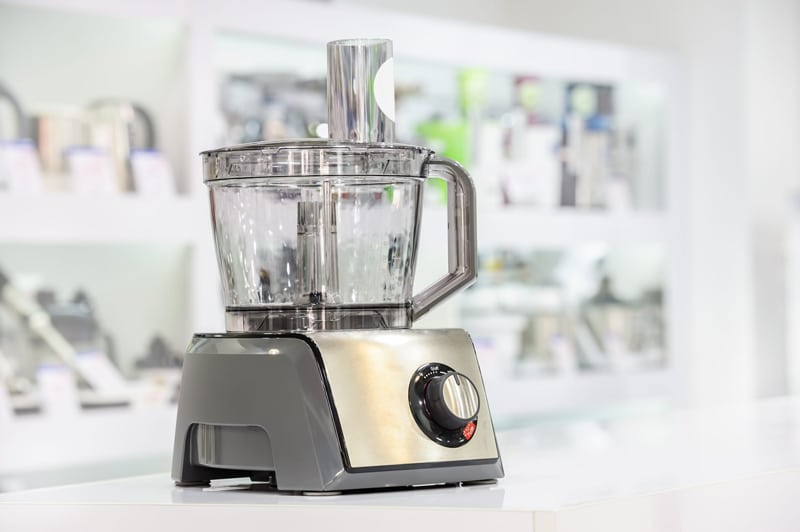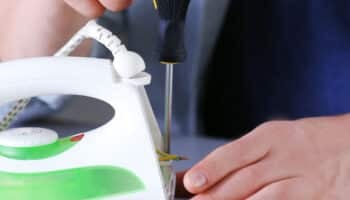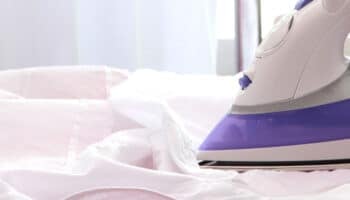Is your food processor not working?
I’ve been there too! Being unable to use your food processor because it’s having issues can be super annoying, especially when you’re entertaining.
But don’t worry; I’m here to help!
If your food processor is not working, it’s probably overfilled, the blades need to be cleaned, or you have power issues. A blown fuse, overheated motor, and broken activation switch can also explain the problem.
Read on to learn how to fix your food processor today!
Food Processor Not Working? 8 Reasons Why (With Fixes)
Whether your food processor is not working at all or simply refuses to spin its blades, I’ll help you solve the issue in this section.
If you have a multimeter and a screwdriver handy, it would be a good idea to bring them out, as we’ll need them to access the food processor internally and test some of its components for viability.

#1 Jammed Blades (Food Residue)
If your food processor is not working because the blades are not spinning, it probably needs to be cleaned.
You see, rarely (or never) disassembling your food processor for a thorough cleaning can cause your blades to get stuck due to food residue, which is not only detrimental to your appliance’s lifespan but also to your health, as you’re likely consuming old food leftovers and mold inadvertently.
Try cleaning the food processor at least once a day. To clean it, you can either put some water and dish soap inside and activate it to let the mixture reach all crevices inside the bowl or disassemble it and clean every part individually.
I personally recommend the latter, as it will guarantee the most hygienic conditions over time. However, there are some tips you must keep in mind:
- It’s best to wash your food processor right after using it, as it will prevent any food from hardening, requiring more effort later on.
- You can use running water to wash the blades and the bowl, but never the motor. It’s best to use a damp cloth for the motor.
- Unless your food processor is dishwasher safe, please do not put it in there. If it is, place it on the top shelve to protect it from the heat at the bottom.
#2 Improper Part Coupling
If you’ve cleaned your food processor, but it’s still malfunctioning because the blades are not spinning, they’re likely loose or improperly coupled.
Failing to adequately put your food processor back together can damage your bowl, motor, and even you.
So, it’s very important that you triple-check that all the components are in order and properly coupled before operating your appliance after cleaning.
Tip: I usually keep a list of all my food processor’s parts and a checklist for reassembling so ITip: don’t forget to put anything back.
#3 Overfilling
I tend to find that when a food processor is not working, it’s typically because it’s overfilled.
You see, exceeding the maximum capacity can have a negative impact on your appliance’s lifespan and functioning, especially when it comes to hard, solid foods like nuts or chocolate.

Overfilling your food processor can also void your warranty and leave you in a very uncomfortable position when trying to get your manufacturer to repair it.
So, please read your user manual again to find the maximum recommended capacity for your food processor. Some models have a “Max” marking engraved on the bowl.
Using your senses also works. If you hear unusually loud noises or a burning smell coming from the motor at any point during operation, stop immediately, remove at least half of the bowl’s content, and let the food processor cool for a couple of minutes.
However, if you entertain guests or cook for your family often using your food processor, it’s best to look for one with a larger bowl to prepare the amount you need in a single batch without straining the motor.
#4 You’re Using a Bad Outlet
If you’re struggling with a food processor that won’t turn on, you’ll need to check the outlet.
You see, a bad outlet could lead to intermittent power supply and voltage fluctuations, affecting your food processor’s operation.
Carefully unplug your food processor from the wall outlet you normally use and plug it back into a different one. The further from the suspected culprit, the better.
Is your food processor working again? Great, you have nothing more to worry about your appliance. However, you should call a professional and address the faulty outlet as soon as possible, as it could be the first symptom of a greater electrical failure in your house.
If you’re confident and up for a challenge, you can test the outlet for continuity with your multimeter.
#5 Your Power Cord Is Damaged
If your food processor won’t turn on, checking the power cord is crucial.
From what I’ve seen, most kitchen appliances’ power cords are much more frail than they seem. In fact, habits like keeping them tangled continuously or strongly pressed against a wall at weird angles are enough to do them in.
If the power cord is broken altogether, your food processor won’t turn on, whereas, if it’s only partially damaged, it can short circuit before breaking down entirely.
It’s unfortunate, but there’s also good news, as fixing the power cord is very simple and quick. You’ll just need to remove the faulty cable and replace it with a new one.
If you don’t have another cable readily available, you can do a quick Google search on your food processor’s make and model to find the corresponding power cord for sale at any online marketplace for less than $20.
#6 The Activation Switch Is Broken
Now, let’s check the activation switch, which is responsible for turning your food processor on and off.
Depending on your food processor’s age, the activation switch could fail or break due to normal wear and tear or other technical factors.
Whatever the case, the end result is that your food processor no longer turns on, and there’s nothing more frustrating than having a working appliance that cannot be activated because of a faulty little button.
To test the activation switch, you’ll need to bring out your multimeter and your screwdriver and follow these steps:
- Unplug your food processor.
- Turn the appliance upside down to expose the screws at the bottom.
- Undo the screws with your screwdriver to expose the food processor’s guts.
- Locate your switch behind the external knob or lever.
- Get comfortable access to it and use your multimeter to test it for continuity. If there’s none, you’ll have to replace the switch.
Keep in mind that replacing the activation switch can be a bit challenging because you’ll need the specific part that fits and works on your food processor’s model. If you’re still under warranty coverage, you can contact your manufacturer for a replacement.

#7 Your Fuse is Blown
Is your food processor not turning on? The fuses have probably blown.
If you’re unfamiliar with how a fuse works, it’s quite simple. The fuses are designed to destroy the filament to interrupt all electrical conduction inside your food processor when they sense a big power surge.
So, if your food processor stopped working right after a big blackout, chances are your fuse blew to protect its internal components. I know it can be a bit of a bittersweet feeling. On one hand, the component saved your appliance, but on the other, it’s no longer working and is vulnerable to future power surges.
To solve the problem, replace the fuse by following the steps from the previous point to access your food processor’s guts. Once you’re in there, look for the fuse and carefully remove it.
Unlike other components, a blown fuse does not require a multimeter to determine its viability. All you have to do is look for blackening inside the glass body and a broken filament. If you identify these signs, it’s time to make a trip to the hardware store.
#8 An Overheated Motor
If your food processor stopped working after an extended period of use, it’s likely overheating.
While most food processor manufacturers have implemented countermeasures and designed improvements to prevent overheating issues, there’s no way to eliminate them completely.
But don’t worry. When your food processor overheats, just let it rest for a couple of minutes until it is cool or warm to the touch. I also recommend splitting your food processing sessions into several shorter periods rather than a few longer ones.
If you don’t allow your food processor to cool down, the motor will burn out and stop working altogether. In such cases, you’ll need to check if your appliance is still under coverage so you can send it to the manufacturer for repairs.
Keep in mind that there are some conditions under which the manufacturer will not validate your warranty. For example, if the user manual says, “Do not exceed x amount of minutes of continuous use” and you used your food processor for longer than that, they will not cover the repairs, so read carefully.
On the other hand, if you’re no longer under coverage or have used your food processor against the manufacturer’s indications, it’s best to replace it altogether.
Wrapping Up: Troubleshooting Your Food Processor
Hopefully, now you know how to fix your food processor issues.
Remember that if your food processor won’t turn on or isn’t working, you must ensure it’s not overfilled and clean it regularly. Don’t forget to inspect the power outlet and cord, check the activation switch, and avoid using it for extended periods.
It’s important to check your warranty before tampering with your food processor, as doing so could void it.
Thank you for sticking with me all the way to the end. If you learned something new and your issue was resolved, why not keep expanding your knowledge with our other wonderful resources below?
Good luck!









